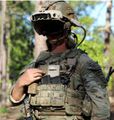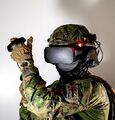Public:ARHUDFM FAQ
Augmented Reality Head-Up Display Fullface Mask (ARHUDFM)
Frequently Asked Questions
Problem
Deficiencies of the human systems used in the U.S. and German armed forces and in NATO: a distributed communication between units and between all soldiers, orientation and navigation considering fast dynamic environmental factors, the effect on concentration when performing multiple simultaneous actions, disadvantages of portable wearable devices, a lack of important additional electronic functions, a high cost of modern equipment.
Several problems and strategic capabilities at once.
1. Distributed communication between units and between all soldiers:
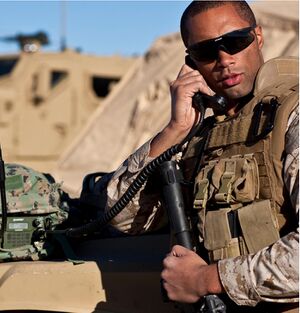
- Quality of communication
- Voice communication with the enemy at a distance
- Encryption
- Simultaneous communication through multiple channels
- Accuracy of information and communication
- Duration of communication sessions
As a rule, the commanders of the individual units have digital remote communication devices with encryption algorithms. However, most of those involved have simpler radios that are suppressed by electronic warfare or suffer interference in terrain with terrain elevation changes. In addition, if the unit is performing tasks in small groups, it lacks communications with other command centers, much less other domains. Voice information is exchanged through nodes, which slows down communication considerably. An important point is certainly the fact that voice communication between NATO units from different countries encounters language barriers.
The solution is a software-defined radio (SDR) embedded in an augmented reality mask that operates flexibly on an extended frequency spectrum and broadband with multiple protocols and with less transmit power. The result is less interference with others and communication errors, more workarounds for radio jamming, and increased transmission range. Multi-channel one-to-many communication shortens the duration of sessions and the speed of data exchange, especially for short text and character messages, graphics, and GPS position exchange. This improves communication and coordination many times over.
Loud communication with the enemy or the population by each fighter avoids misunderstandings.
2. Orientation and navigation considering fast dynamic environmental factors:
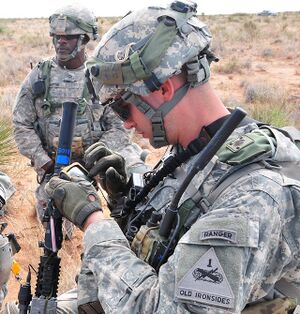
- Friend-or-foe system
- Speed of map reading and positioning
- Exchange of positions within the same unit and especially during inter-domain interaction
- Capture of enemy fire positions and missile launch positions, approach to distant objects, and object recognition
The friend-or-foe system is still a prospective system for all Alliance countries and is not yet widely used. It is not effective without the use of augmented reality technologies. Another problem is the need for rapid target acquisition in the field and real-time navigation with the ability to see the positions of friendly units and vehicles, as well as captured fire positions and enemy movements, detect heat and smoke trails, and distinguish
between civilians. This requires receiving data from the drone and from other friendly units.
The navigation grid should show not only the landscape but also the distance and movement path of friendly and enemy positions, their numbers, and identification codes for communication. The optical ability to zoom in on distant objects, object recognition using computer vision and identification with satellite imagery or electronic maps and day and night thermographic vision combined with optical and infrared spectral vision must be available at all times.
It is important that soldiers are not distracted by these tasks and do not lose sight of their surroundings while using other equipment (navigation device, tablet PC, map, binoculars, rangefinder, thermal imaging camera, radio, and night vision device). All devices should be integrated and not interfere with observation.
3. The effect on concentration when performing multiple simultaneous actions:
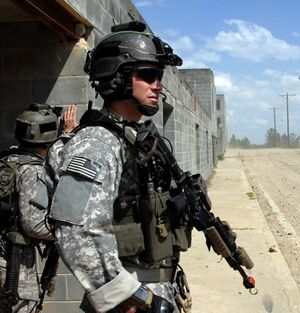
- Observation, detection, and approval
- Execution of the combat task
- Delegating the task to another
- Ballistic measurement and target setting
- Reporting the execution of the task
- Monitoring the execution of the task by others
- Screen view, text input
It is rare for a human to be able to provide two or more thought processes at the same time. For this reason, Air Force pilots have long used the head-up display to show important navigation parameters and target data. Progress and new possibilities overwhelm a person's cognitive abilities. In every domain, including sea and land, the military first conducts surveillance. Immediately upon detection, they must decide if data needs to be shared or if the electronic system needs to take care of it by providing updates to others. If the information is important, confirmation of data sharing should be obtained and possibly coordinated with others.
Whether a combat task must be delegated to or by others, or the decision has been made to perform it oneself, a very simple, clear, and immediate protocol for coordination is required. And an equally simple and concise confirmation of the established outcome. One solution is the use of voice control, auto-tracking, and data exchange via radio communication with symbols, graphics, and written codes.
Another important task that overtaxes a person's cognitive abilities is calculating ballistic parameters and aiming. It does not matter whether the weapon is a handgun, a mortar or an artillery piece. The computer calculates 7 to 12 parameters in milliseconds, often with pre-positioning and corrections, saving time and ammunition.
4. Disadvantages of portable devices:
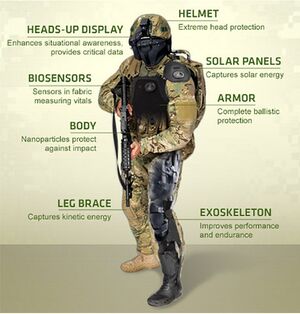
- Dimensions and weight
- Lack of comfort during prolonged wear (pressure on head and face, fogging of goggles and visor, insufficient ventilation of head and face, battery charge)
- Wired communication between devices on the head, back, waist, and chest
- Visibility to the enemy when using glow screens at night
- Lack of integration of the different systems - respirator, face shield, night vision, drinking system, voice communication - into each other
Several different electronic devices must be combined into one, and in doing so, weight and dimensions must be reduced, and freedom of movement must not be restricted. Cables that disturb and endanger the soldier must be inside the devices. High-strength materials and component resistance to water, dust, heat, cold, shock, and vibration should enable the performance of all combat missions. When wearing the device for extended periods, the comfort of the wearer must be ensured. This includes easy breathing through the mask for more than 24 hours, sufficient ventilation of the head and face, and pressure on the soft tissues of the head that does not affect the blood supply. The visor must be protected against fogging. The operating time with a single battery must be more than 24 hours. A drinking system must be built into the mask. The mask must have a ballistic helmet suspension system that can be easily attached and removed with one hand.
The soldier must not be visible at night because of the glowing screen. During the day, the visor must not dazzle in the sun. An important technical solution for the modern soldier's equipment is also the integration of respiratory protection, face protection, visual protection, an integrated drinking system, night vision, and all kinds of communication. In this way, it is equipped for combat operations in different environments and under different threats for long periods of time.
5. Lack of important additional electronic functions:

- Written encrypted communication
- Silent voice communication (acoustic voice isolation)
- Real-time transmission and viewing of images from the drone or robot on each participant's screen
- Transmission and viewing of images from external devices outside the body contour
6. High cost of modern equipment:
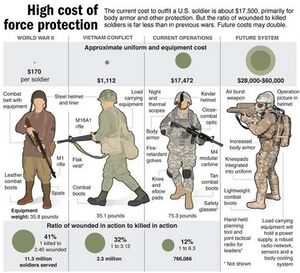
- Night vision and night vision scope
- Thermographic sight
- Optical binoculars and close combat optics
- Radio with encrypted voice transmission
- Navigation device and compass
- Respiratory protection, face protection, and hearing protection
- Helmet and body protection
- Uniforms, footwear, equipment, ammunition
- Armament and first aid equipment
Key factors for Cross-Domain Interaction (CDI)
So the main factors for the CDI concept should be -
- A multiplication of communication through secure communication protocols, not through increased voice communication, but through the exchange of digital data about positions, events, tasks, and execution reports. Primarily written, symbolic, and graphical data that requires less traffic is more objective and understandable in a multilingual environment and is more easily processed by machines, including artificial intelligence (AI).
- The role of a tactical unit commander should not include the role of a communications center. They can focus more on unit coordination. Communication hubs are now machines.
- On the other hand, by following AGILE principles, each combatant, without having to expend additional forces, will not only be able to be a valuable source of data for all levels of command, but also, based on a broader range of processed objective information from other sources, including drones, satellites, and radars, presented in concise form, will be able to make more effective decisions independently without waiting for unnecessary approvals.
- The split between multichannel and machine processing will reduce channel congestion problems and increase the speed of exchanges and decision-making.
- In addition, the fighter's local cognitive superpowers, which are also processed by machines, will enable them to see, hear, and recognize what was previously inaccessible to most people at a lower level. This enables an immediate response both to themselves and to other participants in the same domain and in other domains.
The development of such Cross-Domain Solutions requires:
- Wearable individual helmets with head-up display, sensors, computing modules, SDR, and WLAN
- Adapted protocols for secure multi-channel communication
- New protocols for interaction and decision-making at all levels in various domains, including AI algorithms for big data analysis
- New training protocols for fighters, gunners, technicians, engineers, pilots, and commanders using virtualization technology
-
Wearable individual helmets
-
Adapted protocols for secure communication
-
New protocols for interaction
-
New training protocols
In addition, several strategic opportunities are also part of the problem. In the constant competition for superiority over a potential enemy, this is an important element of the problem assessment.
7. Visual communication:
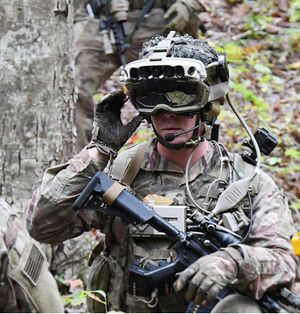
- Exchange of digital position data for fast navigation
- Exchange of symbolic data for quick understanding
- Exchange of graphical information from drones and robots, a transmission of camera images to other units and participants
The location of positions and probable positions are success factors in tactical tasks. However, since the positions of friendly and enemy units can change unpredictably and very quickly, commanders do not always have complete and detailed information, especially for smaller units. It is important that each warrior in each squad group knows in advance what environment he will be in one hour. The most important thing is to be able to distinguish between friendly and enemy units before contact occurs. The concept of "friendly fire" should be abandoned. It is also important to support allied units that are suddenly ambushed and urgently need help from nearby units.
In order to report and receive the information for such navigation in real-time, it must be displayed exclusively in graphical form. It is even more convenient to have the navigation grid constantly in front of one's eyes without disturbing the overall view. The same applies to information collected not only by humans but also by drones. Part of the reconnaissance information must be processed in real-time and forwarded via common channels to
everyone within a certain radius.
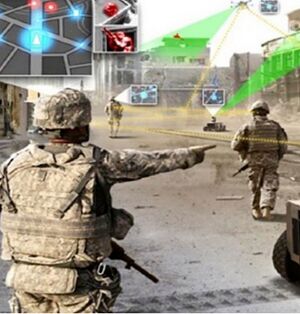
- Enemy firing ranges
- Heat and smoke trails from missile trajectories with an estimation of launch positions
- Faces and objects from a distance
Modern computer vision systems are able to detect objects faster and better than humans by comparing them to previous images. Once an activity has been detected, the machines can analyze firearm flashes, aircraft trajectories, vehicle movements, and ballistic trajectories, as well as examine the heat and smoke trail of missiles in real-time and with high accuracy.
Neural networks can learn very quickly from a relevant data set. The more data, the more accurate the analysis. Progress with these technologies is measured in months, not years. As a rule, high image sharpness is not required for accurate recognition and the algorithms work efficiently even with images and videos of average quality.
Another area for recognition using computer vision is human faces. When patrolling and interacting with civilians, it is important to be able to recognize terrorists and enemy soldiers in civilian clothing. Emotion recognition capabilities are particularly noteworthy. Every human emotion has a wide range of gradations. Beyond that, however, it is usually important to evaluate the combination of emotions.
9. Noise filtering and detection for better orientation and observation
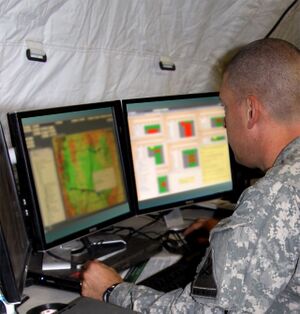
Human hearing is many times less informative than that of animals. At the same time, external microphones and bandpass filters have long been able to pick up and isolate individual sounds, even quiet ones. But this used to be the competence of sound engineers with good experience and developed hearing.
Neural networks are now quickly trained to recognize the right sounds and noises and transmit the results quickly. And it doesn't require much computing power. In practice, such super capabilities as part of a soldier's personal kit will enable even inexperienced personnel to perform reconnaissance tasks much more effectively.
9. Electronic management of tasks (automatic tracking, delegation, proof of completion)
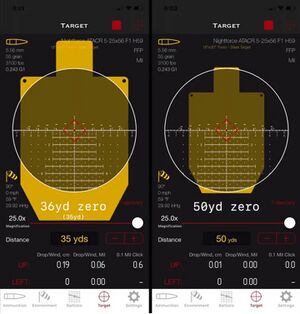
The next technology, which has long been used for civilian purposes, is auto-tracking. The system uses sensors to record the result itself and sends an automatic report on execution without requiring human intervention. This can be taking a position, suppressing enemy fire, leaving the firing zone, apprehending the enemy, recording patrol results, and many other tasks that will not require human intervention. Each soldier just needs to have a computer and turn it on.
10. Electronic ballistic calculation, aiming assistance and correction, instant exchange of enemy positions, and distributed target control
Ballistic calculations have been performed by specialists for decades. And for many sophisticated weapons, computer calculations have also been used for a long time. However, for soldiers not sitting in front of a fire control monitor, for small arms, including snipers, for machine gunners and grenade launchers, for mortar fire, ballistic calculation functions and aids in aiming as well as correction can be useful. Ballistic calculations often use more than 10 parameters, such as range, target location angle (sight line height), wind speed and direction, upward air flows, temperature, relative humidity, precipitation, altitude, barometric pressure, caliber, and type of ballistic projectile. In addition, there are a number of other factors that are rarely considered.
Since the calculation of distances over 400 meters is already a complex task, it is difficult to solve it simply in your head. It is common for professionals to be trained to use tables and correction tables. A computer algorithm makes it possible to use much more accurate results of numerical integration of a system of differential equations. Another task that can be done better with a high-tech assistant is aiming. When not shooting from a closed position, it is much easier for a person to use a digital laser pointer sight integrated into an augmented reality helmet. The shooter aims the laser's crosshairs at the target and, taking corrections into account, immediately sees the likely point of impact.
Business Model
We will work on the basis of two models: Sales and SaaS for application functional modules. Due to the fact that various agencies and military-technical corporations have shown interest in our product, we are planning direct sales in collaboration with them, less likely through direct tenders.
This is a B2B and B2G area. This metric can be double-edged here. If you estimate the cost of a pilot program, CAC could be $120K-160K.
Still, I think there should be more focus on LTV (lifetime value). I assume LTV averages over $400M.
The project is currently at the prototyping stage.
Competition
Neither now nor in the future are we afraid of competition. First, competitors help us to keep a good tone and pace in the work of product development and customer support. Secondly, no competitor is capable of taking a dominant position in this market. Thirdly, none of the experts have any doubts about the great growth potential of the market for years to come.
Currently I would mention the following: Microsoft, L3Harris, C5ISR CCDC (DEVCOM), DARPA, Red 6 & Lockheed Martin, Elbit Systems, Airbus Defense, Smart Shooter, Magic Leap. However, all except Microsoft are either developing an irrelevant product or there has been no confirmation for at least 4 years. We have been researching competitor information regularly for over 2 years.
I see more potential in smaller teams than in the giants. The list of reasons is very long. The main ones are the ability to dive deep into problems and come up with a solution that fits the problems perfectly. If you don't try to invent from the beginning, and adapt a completely different product that hasn't taken off in the B2C market, that's not a good strategy.
It will be a slower path. This is the example Microsoft shows. They are already in their third year of spending the money received under the DoD contract, and news about the IVAS program appears less and less frequently, mostly negative. If you analyze other sectors of the defense technology market, in most cases the new contracts go to medium and even small companies, not to large companies. Big business then seeks to acquire these companies in order to maintain its market share.
Now we can only talk about the future. Because neither we nor our competitors have ready-made products for relevant comparison.
Critical functions
- Active device cooling even at high air temperatures
- Battery life over 72 hours
- No external wiring and modules
- Variable transparency of the central part of the visor
- Built-in respiratory and facial protection from gases, aerosols, dust, bacteria and viruses
- Built-in hands-free drinking system
- Voice and hand tracking control
- Joystick control and virtual keyboard
- Oxygen level, heart rate, body temperature, hydration level sensors (vital body sensors)
- Built-in VHF / UHF band radio
- Built-in SDR (Software Defined Radio) for digital encrypted one-to-many communication
- Written, symbolic and graphical communications for fast and accurate exchange
- Friend-or-foe identification
- Automatic capture, tracking and transmission of enemy positions, incl. out-of-sight (RDF), to other users and HQs
- Auto-tracking of own positions and execution of tasks
- Digital zoom and measurement
- Drone and external cameras view
- Digital aiming system integration
- Rear view
- Ballistic calculations and target hit tracking and corrections
User friendliness
- Active head (under-helmet) ventilation, an extremely valuable feature in a heat of a outfit while on a move, when sweat pours into eyes
- Low breathing resistance of respiratory protection for comfort during prolonged use and high physical exertion
- Acoustic isolation of user speech
- Low pressure on soft tissues of face and head
- External loudspeaker is needed for comfortable voice messaging to people without the device over longer distances or in high noise environments
- Built-in bright light source with adjustable brightness to illuminate the space and work area in front of the user
- Convenient written task system, automatic task control and checklists
- Comfortable system of symbolic communications (analogue of road signs), coupled with an AI system
- Real-time access to library and reference materials
- Accurate shooting with both eyes open
Expanded functionality
- Connectivity with C4I systems
- LiDAR connection (NVG mount, USB) for visibility in conditions inaccessible to IR and optical systems
- Passive radar connection
- External active phased radar connection (remote mobile radar, UAV equipped with radar)
- Missile engines heat & smoke traces (Computer Vision)
- Motion and flashes detection (Computer Vision)
- Face and object recognition (Computer Vision)
- Ambient sound filter (ISR tasks, Machine Learning)
- Training in a mixed Live-Synthetic Environment
Price
- We expect to price the product at an average of $1,350 plus an annual software subscription of $1,440. With an average amortization period of 3-5 years, our revenue per user would be $5,670-8,550.
- The ENVG-B Goggle from L3Harris is priced at $25,400.
- The price of the IVAS from Microsoft is over $55,000.
These are mostly intellectual barriers. Because the cost of development is relatively not high. If a team of like-minded people is gathered for development and if modern development methods are applied in practice, not in words.
Another barrier can be market entry. But in the U.S. alone, there are more than two dozen decision-making centers for a pilot program and contracting. And besides the U.S., there are at least 23 other countries on our list. The total is more than 150 decision-making centers. If we do not take into account the areas of civilian applications (police, security services, firefighters, rescue workers, paramedics). There are already several thousand decision-making centers.
Competitive Advantage
We have a modest opinion of ourselves. I know from experience that my ideas and projects in the past have now found massive validation. My natural curiosity and desire to get to the root cause help me. I also appreciate the broad erudition that our co-founders have. And, of course, great patience to complete many routine tasks that often cannot be closed quickly.
We do not manufacture the components and materials from which the product is created. We do not develop frameworks or software technologies. We invent new designs, develop new electronic circuits and printed circuit boards, develop new technologies for user tasks and new algorithms for software code.
On the contrary, several say they doing. We have confirmation only about the IVAS project from Microsoft. These problems have been discussed at conferences for more than 10 years, the problems are not new. However, previously the level of technology did not allow to create such a product. Now it is possible for many. And I am sure that within a few years, several dozen companies will offer their solutions, and the market will choose the best 10-15 of them.
Our main advantage is that we make a product that meets the needs of users much better, has more prospects for expanding functionality and costs at least 30% less than Microsoft IVAS and L3Harris ENVG-B.
A little above in the question "Compared to your competition, how do you compete with respect to price, features, and performance?" we detail the differences in features and price.
We try to be clear to everyone with whom we discuss the project. With military and security experts, with technical experts and founders of other startups. We get feedback that the problem is clear, the solution fits the problem.
We have a great imagination and can feel things that aren't there yet.
Our product comprehensively solves several problems simultaneously. Whereas our competitors have a solution for one or two problems at most. We were also very careful about long-term comfort, power consumption and battery life, and ensuring sufficient cooling. We pay special attention to the future user experience in the interface, controls, and the application algorithms themselves.
Customer
Customers want first and foremost to solve problems of Cross-Domain Interaction and Situational Awareness. They also want advanced digital vision and hearing capabilities, digital assistants for instant threat response and for combat tasks - ballistic calculations, aiming, correcting, and sharing enemy positions. In a few words, customers want to save more lives of military personnel and give them a greater advantage over the enemy. This applies not only to the military, but also to the police, public and private security services, firefighters and rescue workers.
Military
- Army and Marine Corps operational units
- Army and Marine Corps reconnaissance teams
- Special operations forces, rangers, navy seals, airborne
- Patrol and cover units
- Military engineers and sappers
- Snipers and fire spotters
- Machine gunners and grenade launchers
- Mortar crews
- Artillery crews
- Combat vehicle and tank crews
- National Guard operational units
- Military personnel of Navy ships combat units
- Military personnel of Navy ships technical units
- Deck services of aircraft carriers
- Patrol services of aircraft, naval, regional forces bases
- Operational units of military police
- Paramedics and doctors of medical service, surgeons
There are more than 1,664,000 U.S. troops, 1,561,000 troops of other NATO countries and 1,045,000 troops of allied countries (Israel, Japan and South Korea).
Civilian services
- Coast Guard cutter and ship units
- Customs and Border protection units
- Immigration and Customs Enforcement units
- Police, Sheriff's, SWAT, FBI, DEA, ATF, USSS, USMS operational units
- Police and Sheriff's patrol services
- Patrol services of private security companies
- Professional and volunteer firefighting crews
- Civilian paramedics, doctors and surgeons
The number of police and security officers in the U.S., the EU, the U.K., Israel, Japan, and South Korea exceeds 3,075,000. Even more private security personnel. The number of firefighters in these countries exceeds 4,839,000. The number of surgeries and emergency medical technicians exceeds 1,035,000 and over 1,100,000 private security guards in the U.S. only
Countries
- United States
- United Kingdom
- Canada
- Germany
- Netherlands
- Belgium
- France
- Spain
- Italy
- Denmark
- Norway
- Sweden
- Finland
- Czech Rep.
- Slovakia
- Poland
- Romania
- Slovenia
- Portugal
- Switzerland
- Greece
- Israel
- Japan
- South Korea
Over the past 10 years, the DoD and military experts have developed a clear image and vision for the future in human tactical systems and Cross-Domain Interaction. But there are no ready-made offerings on the market yet. We are aiming for “the blue ocean”.
The project's traction to date includes several Problem-Solution Fit confirmations from U.S. DoD, DARPA, DIU, Lockheed Martin, Bundeswehr and prototype development.
Soldiers and officers who perform tactical combat missions in different combat units in different branches of service: Army, Marine Corps, Navy, Air Force, National Guard, Coast Guard, Border Guard, Customs Service, Medical Service, Military Police, Federal, and Municipal Police, FBI, DEA, ATF, USSS, USMS, Fire Departments, Private Security Services, as well as technical officers of warships, boats, helicopters, combat vehicles, and tanks.
Resistance is inevitable. It is a new experience. However, success depends on the strategy and quality of preparation for the field test. Particularly among U.S. DoD military experts, military-technical corporations and the Bundeswehr, with whom we are already in contact, we see approval and support for our decisions. We expect to jointly develop effective protocols and goals by the time the field test begins so that they are achievable. After that, we will work together with great care to prepare pilot programs and collect user opinions so that we can make the necessary changes in time, but not to allow distractions from the main goals of the solution. The user experience will decide.
There are many agencies that research and develop new human systems for the military, innovative projects and programs to collaborate with small and medium-sized businesses. First and foremost, however, we will rely on the existing channels of military-technical corporations that have extensive experience with contracts with defense and security departments and have a good reputation.
Briefly, customers want to increase the safety and at the same time the efficiency of their employees, create an advantage over the enemy, reduce operations time and stress, provide more comfort and improve communication for the best control of the situation. And they also want to reduce the material costs of ammunition, equipment and the number of combat units used.
We have been doing research for more than two years. We read publications by military and security experts, publications by military conferences, publications and reviews by military bloggers (former military personnel), watch tactical videos, evaluate the opinions of military and technical corporation personnel, and analyze the research programs of military agencies such as DARPA, DEVCOM, ARL, AFRL, AFC, CERDEC, DIU etc.
We hope that the first paying customer will be one of the military-technical corporations with which we are negotiating a collaboration.
Much has been written and said about customer problems. In different countries, the community of military and security experts is united in its opinion. We have received several confirmations of Problem-Solution Fit from Army xTechSearch’6 of U.S. DoD, Defence Innovation Unit of U.S. DoD, DARPA DSO, Lockheed Martin Co. VTC Systems, Planungsamt der Bundeswehr (Abteilung I).
I think the interest is related to the relevance of the problem and the uniqueness of the solution.
We deal with large agencies and corporations. We don't always get answers to our appeals. It often happens that communication channels are very overloaded. And direct appeals to key employees become effective, bypassing the primary filter of less motivated lower-ranking employees. Sometimes it works to mention famous names that have made the first step towards us. Sometimes the contact succeeds on the third or even ninth attempt. Lots of reasons. We strive to be flexible and persistent, but avoiding intrusiveness.
Financials
During this year, about $4,000 a month. However, this is only the cost of materials and services of a two-person team. We need to significantly increase the team and budget in order to multiply the pace of development according to our roadmap. Nevertheless, we now have all the necessary equipment and materials for prototyping (MVP Alpha).
We need the next 18 months for MVP (Beta) development, lab tests and field trials. Immediately after that we are planning a pilot series production. Our estimates for the first year of the production phase are as follows:
| Budget item | Amount |
|---|---|
| 1st annual revenue (devices) | $24,570,000 |
| 1st annual revenue (SaaS subscribes) | $26,210,000 |
| Variable costs (devices) | $14,010,000 |
| Marketing total costs | $4,000,000 |
| Personnel | $2,040,000 |
| Operating costs | $520,000 |
| Equipment | $190,000 |
| Rental and leasing | $360,000 |
| EBITDA | $29,660,000 |
| Taxes | $9,790,000 |
| Net income | $19,870,000 |
| Budget item | Amount | Q2 2024 | Q3 2024 | Q4 2024 | Q1 2025 |
|---|---|---|---|---|---|
| production, pcs | 18,200 | 1,300 | 2,600 | 5,200 | 9,100 |
| number of subscriptions | 18,200 | 1,300 | 2,600 | 5,200 | 9,100 |
In Pre-Seed round, the goal is to iterate towards first versions of the product, laboratory and field tests.
| $110,000 | 6% | Materials |
| $970,000 | 55% | Personnel |
| $600,000 | 34% | Fixed costs |
| $70,000 | 4% | Reserve |
| $1,750,000 | 100% | Pre-seed round funding |
In Seed round, the goal is the production.
| $3,000,000 | 45% | Materials |
| $1,300,000 | 19% | Marketing (cash) |
| $2,000,000 | 30% | Fixed costs |
| $400,000 | 6% | Reserve |
| $6,700,000 | 100% | Seed round funding |
| Cash flow item | Amount |
|---|---|
| Seed round investment | $6,700,000 |
| Sales cash | $48,070,000 |
| Materials | $6,700,000 |
| Seed round investment | -$14,014,000 |
| Marketing budget (cash) | -$1,300,000 |
| Personnel budget | -$2,040,000 |
| Operating costs budget | -$520,000 |
| Equipment budget | -$190,000 |
| Rental and leasing budget | -$360,000 |
| Taxes | -$9,790,000 |
| Cash flow | $26,556,000 |
ESOP class B preferred shares (Q2 2024 - Q1 2025) - 0.798%, 86,580 shares, $200,000.
Q1 2025
$1,750,000 - Pre-Seed round
$6,700,000 - Seed round
| $1,350 | 100% | Weighted average unit price (device) |
| $770 | 57% | Direct costs |
| $205 | 15% | Indirect costs |
| $375 | 28% | Margin |
We expect the share of indirect costs to decrease over the future time due to productivity growth after the introduction of robotic injection molding, painting, assembly, and packaging lines, as well as after the introduction of the 2nd, 3rd, and 4th lines.
We did not do a unit economy calculation for the software development business process. However, we did include summary data in the revenue and expense budget and in the cash flow budget.
We will need time to fine-tune the production technology, and then to fine-tune the robotic lines.
Key metrics:
- Speed of development and testing within each sprint
- Code quality, software product performance
- Number of product iterations
- Number and estimated size of bugs
- Power consumption of electronic modules
- Compliance with R&D budget
- Quality of field test results
- Consistency with the funnel of collaboration and sales negotiation processes
- Compliance with supplier and contractor (PCB) lead times
- Timing of entry into the mechanical, molding, painting, assembly, and packaging areas
- Compliance with serial production quality
- Productivity of each area and each unit
- Production cycle time
- Amount of expenditures for rejects and business wastes
- Compliance with revenue and expense budgets and cash flow
- Compliance with minimum margins (unit economy and prices)
Fundraising
We received a $50,000 non-reimbursable grant.
The company formed share capital on the incorporation of $5,000. The company did not raise any debt funds.
We hope to raise funding during Q4 2022 - Q1 2023.
It is not possible to make an assessment at the Pre-Seed stage. We believe that the evaluation of a set of co-founder results and their future potential (with the probability of increasing the number of co-founders from 2 to 4), the evaluation of market potential, the evaluation of future market positioning, the evaluation of intangible assets, in total could amount to $25,000,000 (pre-money).
Equity
$1,750,000
$25,000,000
This is the first round of funding.
| $110,000 | 6% | Materials |
| $970,000 | 55% | Personnel |
| $600,000 | 34% | Fixed costs |
| $70,000 | 4% | Reserve |
| $1,750,000 | 100% | Pre-seed round funding |
The plan is for 18 months, during which time we intend to create 7 or more iterations of the product and software apps, test under laboratory conditions (vibration, shock, cold, heat, moisture, dust, gases, acids) and get field test results in the Army and Marine Corps. After changes based on tests, we will be ready immediately for mass production of small series and simultaneously for the construction of a robotic production line with high production capacity.
Results:
- At least 120 prototypes for Army and Marine Corps field tests in 2024.
- Opportunities to negotiate procurement contracts for mass production and regular deliveries of up to 250,000 kits within 4 years.
- Opportunities to develop the software and provide regular updates as part of the licenses in addition to procurement contracts.
Growth & Marketing
Answer.
Answer.
Answer.
Answer.
Answer.
Answer.
Answer.
Answer.
Answer.
Answer.
Answer.
Answer.
Answer.
Answer.
Why do the reluctant users hold back? Where do new users come from? How many users do you have? How will customers and/or users find out about you? What is your distribution strategy? What is your user growth rate? What is your growth like? What makes new users try you? What’s the conversion rate? How much does customer acquisition cost? How do you define success for you and your company? What is the projected lifetime value of a customer? What advertising will you be doing? What is the typical sales cycle between initial customer contact and closing of a sale?
Idea
Vision Military, police, firefighters, and physicians, have super vision, super hearing, super respiratory and facial protection, a built-in drinking system, an advanced communication system, and various digital assistants using AR, AI, voice control, and hand tracking.
We had and still have six ideas for projects:
- Augmented Reality Head-Up Display Fullface Mask (ARHUDFM)
- Unmanned Stealth Armored Multipurpose Wheeled Vehicle (USAMWV)
- Intelligence Surveillance Reconnaissance Airship Drone with Radio Relay (ISRADRR)
- Fast Sailing Trimaran with Hydrofoils and Unmanned Control (FSTHUC)
- Remotely Operated Underwater Observation Drone (ROUOD)
- Unmanned Airships Chain for Wildfire Splinker System (UACWSS)
Each is exciting and relies on a large fast-growing market, at least $5 BN, more often $11-15 BN. There are differences in the speed of MVP development and the speed of consumer conquest.
ARHUDFM project in our opinion was and still is the most attractive because of the market potential, the ability to develop the product faster, the ability to scale production faster, and most importantly - the lowest expected level of competition.
This is necessary in the development process and to get more feedback from experts and first users. Our idea has already evolved considerably during our research and the start of prototyping.
I don't think so. We are confident in the research we have already done, and we also rely on the confirmation of several reputable sources.
If you have no empathy for this project, then could you explain what this is about. Our project, despite its military application as the dominant one, is an idea that aims to increase security around the world.
Yes, and we will continue to do so in the future.
Originally, the target audience was only firefighters, the feature set was very different, the look and internal content was different. I am sure that after several iterations of R&D, the idea of the project will still improve and become even more grounded and attractive.
Legal
Answer.
Answer.
Answer.
Answer.
Answer.
Answer.
Answer.
Answer.
Answer.
Answer.
Answer.
Have you incorporated, or formed any legal entity (like an LLC) yet? What kind of entity and in what state or country was the entity formed? Will you reincorporate as a US company? Please describe the breakdown of the equity ownership in percentages among the founders, employees, and any other stockholders. Are any of the founders covered by noncompetes or intellectual property agreements that overlap with your project? Who writes code, or does other technical work on your product? Was any of it done by a non-founder? Is there anything else we should know about your company? What key intellectual property does the company have (patents, patents pending, copyrights, trade secrets, trademarks, domain names)? What comfort do you have that the company’s intellectual property does not violate the rights of a third party? How was the company’s intellectual property developed? Would any prior employers of a team member have a potential claim to the company’s intellectual property?
Market
Soldiers and officers who perform tactical combat missions in different combat units in different branches of service: Army, Marine Corps, Navy, Air Force, National Guard, Coast Guard, Border Guard, Customs Service, Medical Service, Military Police, Federal, and Municipal Police, FBI, DEA, ATF, USSS, USMS, Fire Departments, Private Security Services, as well as technical officers of warships, boats, helicopters, combat vehicles, and tanks.
A more accurate answer to this question is that this solution is needed first and foremost by senior and mid-ranking officers who plan and are responsible for the outcome of combat tactical operations, as well as public and private security managers, fire department managers, and emergency medical directors.
TAM (Total Available Market): more than 5.7M users per year.
There are more than 1,664,000 U.S. troops, 1,561,000 troops of other NATO countries and 1,045,000 troops of allied countries (Israel, Japan and South Korea).
The number of police and security officers in the U.S., the EU, the U.K., Israel, Japan, and South Korea exceeds 3,075,000. Even more private security personnel. The number of firefighters in these countries exceeds 4,839,000.
The number of surgeries and emergency medical technicians exceeds 1,035,000 and over 1,100,000 private security guards in the U.S. only.
Average lifetime of 2.5 years (the average amortization period of the product is 3-5 years).
SAM (Serviceable Available Market): more than 4.0M users per year.
SAM consists of military personnel, security officers, fire departments, medical personnel who are out of the office and do not have the comfort of a personal computer, as well as those who perform tactical, operational and rescue tasks. According to various estimates, the proportion of such personnel exceeds 70%.
SOM (Serviceable Obtainable Market): up to 1.4M kits per year or $3.92 BN. After successful field tests, contracts are awarded: 18,000 kits / 1st year production capabilities. After assembly robotization and up to 4 lines: x16 productivity or 288,000 kits / 3rd year. After launching 2nd production: x79 or 1.4M kits / 5th year. Prospective market share of 35%. The approximate weighted average price of the kit will be $2,800 (hardware + software subscribes + wear parts).
This project has a great depth of software development that allows Augmented Reality, Artificial Intelligence, Computer Vision to be used for defense and security purposes, as well as water rescue and emergency services. In addition, this technology has a large application in surgery, dentistry, sports medicine, and other medical fields where the doctor works with the patient with two hands.
We estimate that over 5 years, the amount of revenue could exceed $1,447M and the discounted cash flow (taking into account the current high inflation >6%) could exceed $656M.
Market Validation
- Military experts on active duty
- Security experts
- Advisors and consultants, retired senior officers
- Military bloggers
- Military journalists and columnists
- Defense technology scientists
- Proceedings of the Military Professionals' Conferences
- Publications in official and news media
- Interviews with senior officers, instructors, and experts
- IT trend analysis
- BAA request lists to DARPA
- Current EMail newsletters listing topics for Lockheed Martin and DARPA submissions through the SBIR program
- Analysis of corporate websites of large and medium-sized military-technical corporations
| Feature | MVP Alpha | MVP Beta | MMP Gamma | MMP Delta |
|---|---|---|---|---|
| Hardware: | ||||
| Two HD / IR cameras | + | + | + | + |
| Multimedia system | + | + | + | + |
| Media integration via Bluetooth | + | + | + | + |
| DLP optical scheme FOV 105° | + | + | + | + |
| Low breathing resistance of respiratory and visual protection | + | + | + | + |
| Built-in drinking system | + | + | + | + |
| Built-in bright light source with adjustable brightness | + | + | + | + |
| External loudspeaker | + | + | + | + |
| Handheld portable VHF / UHF radio integration | + | + | + | + |
| Active head (under-helmet) ventilation | + | + | + | + |
| Open and closed communications | + | + | + | + |
| Integration with ballistic helmet | - | + | + | + |
| Vitals body sensors | - | + | + | + |
| Built-in Software Defined Radio | - | - | + | + |
| LiDAR | - | - | + | + |
| Ultrasonic sensors | - | - | + | + |
| Embedded passive radar | - | - | - | + |
| External active phased radar connection (remote mobile radar, UAV equipped with radar) | - | - | - | + |
| Software: | ||||
| Graphic User Interface | + | + | + | + |
| Voice control | + | + | + | + |
| Speech-to-text | + | + | + | + |
| Virtual keyboard | + | + | + | + |
| Maps, compass and GPS positioning | + | + | + | + |
| Hand tracking control | - | + | + | + |
| Friend-or-foe identification (Bluetooth, p2p WLAN / Wi-Fi Direct | - | + | + | + |
| Night vision | - | + | + | + |
| Thermal imaging vision | - | + | + | + |
| Stereo camera | - | + | + | + |
| Digital zoom and distance measurement (Computer Vision) | - | + | + | + |
| Angle, speed, temperature, pressure, humidity measurement (Computer Vision) | - | + | + | + |
| Drone and external cameras view | - | + | + | + |
| Digital aiming system integration | - | + | + | + |
| Rear view | - | + | + | + |
| Voice, text, icons and images messenger (voice, text, visual communications) | - | + | + | + |
| Video recording | - | + | + | + |
| Navigation (Artificial Intelligence) | - | + | + | + |
| Ballistic calculations and shooting history | - | + | + | + |
| Task management and checklists | - | + | + | + |
| Oxygen level, heart rate, body temperature, hydration level sensors data-driven monitoring | - | + | + | + |
| Software Defined Radio | - | - | + | + |
| Firing assistance (auto-capture, aiming, correction, hit tracking) | - | - | + | + |
| Mixed vision HD / IR / Thermo / LiDAR | - | - | + | + |
| Geolocation capture, own and enemy positions exchange (Computer Vision, Artificial Intelligence) | - | - | + | + |
| Auto-tracking of own positions and execution of tasks (Artificial Intelligence) | - | - | + | + |
| Radio Direction Finding (friend-or-foe identification) | - | - | + | + |
| Real-time access to library (Wiki) and reference materials | - | - | + | + |
| Face and object recognition (Computer Vision, Artificial Intelligence) | - | - | + | + |
| Motion and flashes detection (Computer Vision, Artificial Intelligence) | - | - | + | + |
| C4I integration (Artificial Intelligence) | - | - | + | + |
| Missile engines heat & smoke traces (Computer Vision, Artificial Intelligence) | - | - | - | + |
| Ambient sound filter (ISR tasks, Machine Learning) | - | - | - | + |
| Emotion assessment (Computer Vision, Artificial Intelligence) | - | - | - | + |
| EHR integration | - | - | - | + |
| Live-synthetic training environment (Computer Vision, Artificial Intelligence) | - | - | - | + |
Product & Technology
We are planning the next stages of product development (Hardware and Software):
- MVP Alpha - the first stage of development after prototyping between the Pre-Seed round and Seed round to use this version in lab tests
- MVP Beta - the second stage of MVP development between the Pre-Seed round and Seed round with bug fixes and functionality extensions to use this version in field testing
- MMP Gamma - the third stage of finished marketing product development after Seed round with MVP fixes to use this version in pilot deployment programs
- MMP Delta - the fourth stage of developing a finished marketing product to improve and expand functionality, and to form a product line for different optional purposes
Within each stage, there are typically up to 4-5 iterations of the product. For more details on the composition of the functionality of each stage, see here.
Augmented Reality Head-Up Display Fullface Mask (ARHUDFM) is the Tactical Augmented Reality Electronic Device - disruptive human capabilities for a tactical advantage along with comfortable respiratory and facial protection (removable module). Our technology opens up opportunities that are always at your fingertips: situational awareness, silent multichannel digital communications, ultimate security features at night, firing assistance, Computer Vision, Artificial Intelligence, a personal high-end respiratory protection system (gases, aerosols, dust, bacteria, viruses) with integrated drinking system and a negligible breathing resistance, civilian applications for physicians, surgeons, firefighters, and police.
For more details on the composition of the functionality of each stage, see here.
1. Конструкция маски

Данный продукт предоставляет возможность использовать его без съёмного нижнего модуля маски, который предназначен для защиты органов дыхания, и встроенной питьевой системы без использования рук. Класс защиты органов дыхания один из самых высоких. Для этого используются два сменных ULPA фильтра, которые обеспечивают уровень защиты 99.9995% от газов, аэрозолей, пыли, бактерий и вирусов. Это универсальный тип фильтра, который имеет дополнительную засыпку из обработанного активированного угля. Фильтры защищены от попадания влаги в соответствии с IP67 или выше. Общая площадь двух фильтров рассчитана с запасом, чтобы сопротивление дыханию было насколько возможно минимальным, ниже, чем у аналогов, серийно выпускаемых ведущими производителями 3M, MCA, Dräger и др. Мы предполагаем, что человек в маске сможет дышать без затруднений даже во время интенсивных физических нагрузок. Для защиты органов дыхания от монооксида углерода будет разработана специальная модификация сменных фильтров. Это важно для пожарных при работе с ландшафтными очагами возгорания и для ликвидации очагов возгорания строительных конструкций. Кроме того, с помощью адаптера вместо крышки одного из фильтров предусмотрено присоединение редуктора сжатого воздуха систем SCBA (Self Contained Breathing Apparatus). Вторая крышка при использовании SCBA блокирует доступ загрязнённого воздуха.
Маска защищает лицо в области глаз, ушей, лба и затылка от осколков стекла, древесной щепы, камней, песчаной взвеси, которые могут иметь высокую кинетическую энергию и вызывать поверхностные и проникающие ранения лица и головы. Вместе с нижней частью модуля защиты органов дыхания лицо защищено полностью. В ближайшей перспективе маска не обеспечивает защиту от баллистического поражения и осколков на излёте, в отличие от сертифицированных баллистических шлемов 1 и 2 класса (IIIA NIJ). Мы думаем над тем, чтобы в будущем сделать модификацию, усиленную волокнами карбона. Маска не соответствует производимым в настоящее время конструкциям баллистических шлемов из кевлара (волокна арамида). Мы разработали специальную конструкцию баллистического шлема и шлема для пожарных, которые будут выпускать наши партнёры.
В зоне наушников предусмотрены технологические отверстия, чтобы человек не терял аккустическую осведомлённость при использовании маски. В затылочной части маски предусмотрены технологические отверстия для вентиляции электронных компонентов с направлением потока воздуха сверху вниз. Это обеспечивает дополнительно активную вентиляцию подшлемного пространства пользователя, а с другой стороны направляет тёплый воздух в область шеи, что также обеспечивает комфорт при использовании, особенно в прохладное время года.
2. Характеристики маски

Несмотря на кажущийся большой вес маски (около 1.3 кг или 2.8 lbs, без съёмного нижнего модуля маски 0.7 кг или 1,5 lbs) вместе с баллистическим шлемом 2-го класса (1.5 кг или 3.3 lbs) масса распределена по голове равномерно и имеет низкий крутящий момент, существенно более низкий по сравнению с современными приборами ночного видения, сильно выступающими спереди. По мнению военных экспертов, крутящий момент имеет существенно большее значение, чем статическая масса. Для сравнения приводим массу шлемов, которые широко применяются сегодня:
- шлем 2 класса (IIIA NIJ) (1.5 кг или 3.3 lbs) + прибор ночного видения (1.2 кг или 2.7 lbs) = 2.7 кг или 6.0 lbs
- шлем пожарного (1.5 кг или 3.3 lbs) + фонарь (200 г или 0.4 lbs) + полнолицевая маска (650 г или 1.4 lbs) + редуктор сжатого воздуха (300 г или 0.7 lbs) + радиогарнитура (145 г или 0.3 lbs) = 2.8 кг или 6.2 lbs
- шлем 2-го класса для сил специальных операций из титана или композитных материалов с забралом (2.5-4.5 кг или 5.5-9.9 lbs) и радиогарнитурой = 2.7-4.7 кг или 6.0-10.2 lbs
- мотошлем интегральный (1.3-1.6 кг или 2.9-3.5 lbs) + радиогарнитура (145 г или 0.3 lbs) + аэродинамическое давление на скорости >100 миль (4-9 кг или 8.8-19.8 lbs) = 5.4-10.7 кг или 11.9-23.6 lbs
Мы предъявляем высокие гигиенические требования к продукту. Материалы не вызывают аллергических реакций. Класс влаго- и пылезащиты IP67 или выше. Электронные компоненты находятся в герметичном пространстве прочного корпуса и имеют активное охлаждение с алюминиевым радиатором на верхней части корпуса и на внутренней поверхности спереди. Маска имеет сменные элементы: 2 воздушных фильтра, 2 крышки фильтров, 1 уплотнитель контура лица. Маска может очищаться с помощью воды и спиртосодержащих аэрозолей снаружи и изнутри. Мы не рекомендуем использовать спиртосодержащие средства для обработки прозрачного визора, это может привести к помутнению.
Также мы предусмотрели разные наборы функциональности в зависимости от специализации пользователя. Например, в одни модификации будут добавлены дополнительные средства цифровой связи, продвинутые возможности зрения и слуха, цифровые ассистенты, а для других модификаций некоторые возможности не требуются. Все модификации физического продукта похожи. Они отличаются составом электронных модулей и производительностью.
Размер маски регулируется по размеру и форме головы с помощью расположенных сзади вращающихся элементов с фиксатором. При этом, чтобы максимально снизить ощущаемое давление на мягкие ткани лба и затылка в конструкции предусмотрены 14 мягких демпфера. Их площадь и геометрия достаточна, чтобы маска плотно держалась на голове, при этом одновременно сила давления равномерно распределялась там, где это не создаёт дискомфорт и не затрудняет кровообращение в мягких тканях головы. Четыре жёстких натяжителя соединяют переднюю и заднюю части маски. Чтобы снять маску, необходимо зажать двумя пальцами фиксатор замка, расположенного за ушами. Это можно легко сделать одной рукой в перчатках или без. После этого маска всё ещё остаётся на голове и спадает. После снятия маски, её можно сложить и уменьшить габаритные размеры.
3. Удобство эксплуатации маски

Мы категорически против любых внешних соединений и кабелей, что может приводить к неудобствам и создавать опасность. Однако в отдельных случаях альтернативы не существует. Поэтому мы расположили места присоединения таким образом, чтобы свободно висящие кабели и шланги располагались по возможности сзади и пользователь не мог случайно их зацепить. К маске могут быть присоединены:
- шланг питьевой системы, расположенной в рюкзаке, через герметичный разъём справа, рядом с крышкой правого фильтра
- кабель внешней антенны UHF / VHF через BNC коннектор в затылочной части
- кабель зарядки батареи маски через коннектор в затылочной части (обычно зарядки хватает более, чем на 72 часа, но может использоваться powerbank)
- Handheld portable radio через коннектор на левом наушнике (встроенная гарнитура, не требуется, если используется встроенное UHF / VHF Software Defined Radio)
- воздушный шланг к редуктору на месте крышки фильтра слева или справа (обычно используют пожарные и спасатели)
- внешнее устройство (фонарь, LiDAR, passive radar, другие сенсоры) через NVG mount на передней части маски сверху
Мы изучаем перспективные возможности для безопасности военнослужащих, такие как использование сенсоров (детекторов) для дистанционного обнаружения растяжек с взрывчатым веществом (мин-ловушек), мин нажимного действия и самодельных взрывчатых устройств (СВУ), срабатываемых при приближении. В будущем при успешных результатах мы предоставим в качестве опции такие внешние устройства для крепления через NVG mount.
Для использования с разным назначением в маску встроены следующие электронные компоненты:
- LED яркий фонарь с регулируемым уровнем освещённости и несколькими режимами (в т.ч. сигнал SOS)
- громкоговоритель с регулируемым уровнем звука может применяться для передачи голоса на большее расстояние, чем обычно, и в условиях высокого уровня шума
- внешний микрофон позволяет усиливать уровень окружающего звука до слышимого человеческим ухом, а также является элементом системы Ambient Sound Filter, которая позволяет программно выделять и подавлять не только определённые несущие на разных звуковых частотах, но и формировать рекомендации пользователю
- внутренний микрофон встроен в обтюратор маски и позволяет пользователю использовать голос для общения и для голосового управления, при этом оставаясь неслышимым окружающим людям
- наушники выполняют функцию воспроизведения звука, защищают от высокого уровня шума, защищают уши и часть головы от внешнего воздействия, а также имеют технлогические отверстия, которые позволяют пользователю не терять аккустическую осведомлённость без использования электронных ассистентов
- две HD / IR камеры спереди и одна камера заднего вида позволяют записывать видео и статические изображения для мониторинга, анализа, увеличения изображения, передачи другим пользователям, а также применяются в сервисах Computer Vision и в режиме стереокамеры для измерений, кроме того с использованием ИК излучателя подсветки камеры передают изображение в ночное время, видимое в инфракрасном спектре (ночное видение)
- термографическа камера спереди передаёт пользователю видео и статические изображения, показывая температуру окружающих объектов
Маска разработана для длительного ношения, поэтому она содержит батарею с большим сроком жизни (более 72 часов). Комфорт при длительном использовании отличает маски от большинства других устройств, носимых на голове. В частности маску отличает очень низкое сопротивление дыханию при защите органов дыхания и очень низкое давление на мягкие ткани лица и головы. Чтобы пользователь не испытывал обезвоживания, в маску встроена питьевая система. Конструкция маски защищает глаза пользователя от прямых солнечных лучей, а также визор маски имеет затемнение.
4. Особенности маски

Маска, как любая другая маски или очки ограничивает видимость в периферийной зоне снизу примерно на 30% видимой нижней периферийной зоны. Мы считаем это приемлемым и в будущем будем проводить исследования и испытания, чтобы по-возможности снизить этот эффект.
При использовании проекционной системы на экран визора изнутри под углом примерно 25° к линии взгляда направлены луч света. При этом лицо человека в маске подсвечивается незначительно и не влияет на усиление видимости пользователя в темноте. Источник луча может быть заметен окружающим в темноте с близкого расстояния только, если пользователь значительно поднимет голову. Для уменьшения эффекта засветки солнечным светом экрана (визора), корпус маски имеет солнезащитный козырёк. Визор маски изготовлен из прозрачного полиуретана, по прочности сопоставимым с поликарбонатом. Как и любая маска или очки визор может создавать блики при низком расположении солнца или источников искусственного света.
Предусмотрена интеграция со баллистическим шлемом, шлемом для пожарных и спасателей. Разработана конструкция шлемов, производство которых будет выполняться нашими партнёрами, которые в настоящее время имеют большой опыт производства такой продукции.
Органы управления:
- кнопки на левом и правом корпусе наушников
- джойстик на правом корпусе наушника
- Hand tracking control
- Voice control
5. Функции программного обеспечения. Краткий обзор

For more details on the composition of the functionality of each stage, see here.
a. Situational Awareness
- digital zoom
- rear view
- night vision
- thermal image vision (ambient and object temperature monitoring)
- no-visibility navigation (LiDAR and sensors)
- mixed vision (HD / IR cam + thermal image cam + LiDAR / sonar dots map, silhouette highlighting)
- stereo camera and measurement
- drone, robot and external cameras view (другие точки обзора, вид с камер других пользователей, вид с камеры цифрового прицела)
- friend-or-foe identification (incl. 360° navigation grid)
- radio direction finding system or RDF (позволяет обнаруживать координаты радиопередающих источников, идентифицировать их)
- vitals body sensors data (oxygen level, heart rate, body temperature, hydration level sensors data-driven monitoring; also another users data view)
- key monitor indicators and images before the eyes
- обнаружение мин-ловушек (растяжек, радио, инфракрасных), мин нажимного действия
b. Communication

- one-to-many communication (объединение коммуникационных каналов, текстовый и голосовой онлайн чат full duplex без нажатия на тангенту - UHF / VHF, Bluetooth, WLAN or Wi-Fi (IEEE 802.11) / Wi-Fi Direct (p2p), LTE / 5G, SatCom Ka / Ku / V)
- voice, text, icons, and images (silent multichannel digital communications, возможность мгновенной коммуникации с помощью icons по примеру дорожных знаков и жестов тактических групп)
- speech-to-text
- Software Defined Radio (значительно меньше трафик и промех, короче сессии, выше качество и защищённость, передача широкополосного сигнала - связь один-ко-многим, совместимость с аналоговыми радиопередающими устройствами, показывает панораму всего радиоэфира в данном месте, анализирует спектр, определяет слабые сигналы и источники радиопомех - ISR функция, документирование радиоперехватов за счёт быстрого АЦП)
- videoconferencing
c. Navigation
- maps and mapping
- compass
- route planning and path tracking (Artificial Intelligence)
- geolocation position exchange (own, friend, and enemy positions, incl. Cross-Domain Interaction)
- auto-tracking of own positions and execution of tasks (Artificial Intelligence)
d. Firing Assistance
- targets auto-capture and tracking (target lock & track, target detection)
- ballistic calculation (instant evaluation of external factors, distance, angle, satellite weather data, and multiple modes of aiming correction)
- speed measurement and calculation of preemptive
- instant aiming (integration with the digital and laser aiming devices, accurate shooting with both eyes open)
- target hit tracking and corrections
- easy access to shot history
• shooter's field of view and especially peripheral areas are not obstructed by the scope;
e. Detection

- passive radar detection
- external active phased radar connection (remote mobile radar, UAV equipped with radar)
- capture of enemy fire positions and missile launch positions (direct and indirect fire positions)
- motion and flashes detection
- missile engines heat & smoke traces
- face and object recognition
- emotion assessment;
- ambient sound filter (noise filtering and detection, identification)
f. Task management
- task control and checklists (ongoing, set by me, assisting, following)
- video and image recording, proof of completion
- task delegation and status monitoring
- reporting and auto-tracking
- connectivity with C4I systems and Battle Management Systems (electronic warfare systems, C4ISR / C5ISR: Elbit Systems, Rheinmetall, Leonardo, Lockheed Martin etc.)
- real-time access to library and reference materials
- patient records and diagnostic cards (EHR integration)
g. Live-synthetic training environment (L-STE)

- mission preparation, mission rehearsal, mission analysis, mission debriefing
- C4I training (Cross-Domain Interaction, coordinating ground maneuver with fast air)
- training courses for the C4I staff with varied and customizable training paths
- support to functional and operational integration of heterogeneous tools (experienced tank training simulators, VR tank and combat vehicle simulators, flight simulators etc.)
- training and expert certification
"Current virtual training has several shortcomings:
- it is not realistic or dynamic;
- it does not simulate human interaction;
- it is too sterile;
- it does not optimally collect data;
- it does not train cross-domain convergence;
- it is not interoperable;
- it is difficult to access; and
- it does not integrate with live and constructive training."[1]
Answer.
Answer.
Answer. Difference table
Answer.
Answer.
Answer.
Answer.
Answer.
Answer.
Recruiting
Answer.
Answer.
Answer.
Who would be your next hire? Who would you hire or how would you add to your team? How many employees do you have?
Roadmap
Answer.
Answer.
What are you going to do next? Six months from now, what’s going to be your biggest problem?
Team
Answer.
Answer.
Answer.
Answer.
Answer.
Answer.
Answer.
Answer.
Answer.
Answer.
Who is “the boss”?
Will your team stick at this?
How did your team meet?
Who in your team does what?
What domain expertise do you have?
Why did your team get together?
In what ways are you resourceful?
Would you relocate to X?
What will you do if we don’t fund you?
How do we know your team will stick together?
Team Experience
Answer.
Answer.
Answer.
Answer.
Answer.
Answer.
Answer.
Answer.
Answer.
Answer.
Answer.
What else have you created together? What’s the worst thing that has happened? What’s an impressive thing you have done? Tell us something surprising you have done? What problems/hurdles are you anticipating? What obstacles will you face and how will you overcome them? What’s the funniest thing that has happened to you? What systems have you hacked? What’s the biggest mistake you have made? Tell us about a tough problem you solved? What’s the funniest thing that has happened to you?
Timing
Answer.
Why hasn’t this worked before?
See also
- 7-min pitch
- Pitch Deck for Business Angels
- Calculations
- Business Processes Flowchart
- Production Scheme
References
- ↑ Second Lieutenant Jeremiah Rozman, U.S. Army, PhD, ''The synthetic training environment", "AUSA", (Arlington, VA: Association of the United States Army - AUSA, December 10, 2020)
